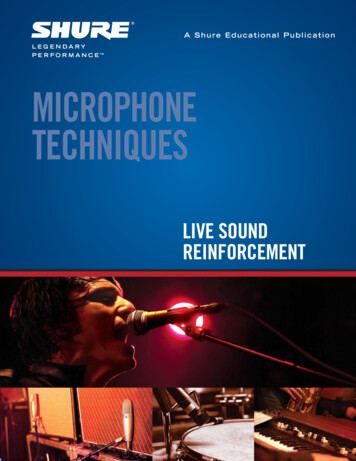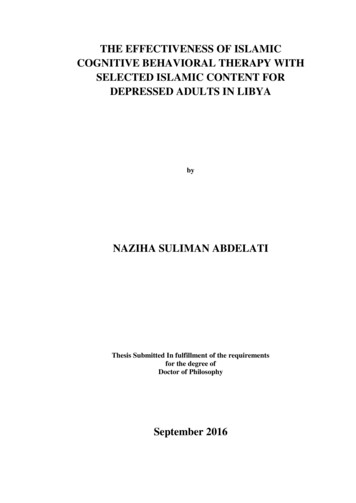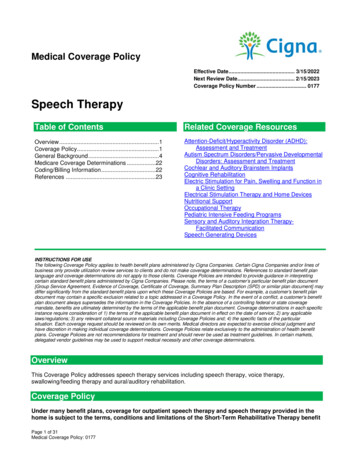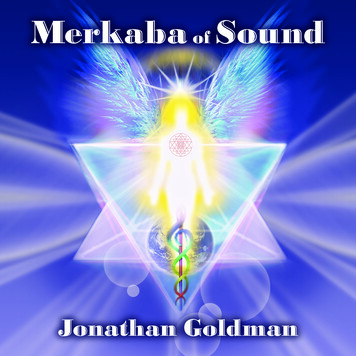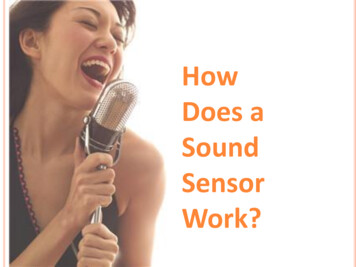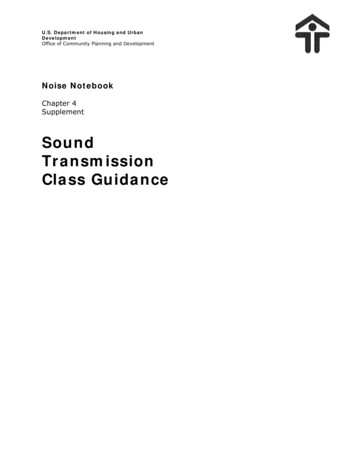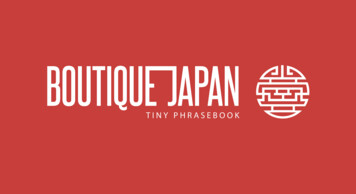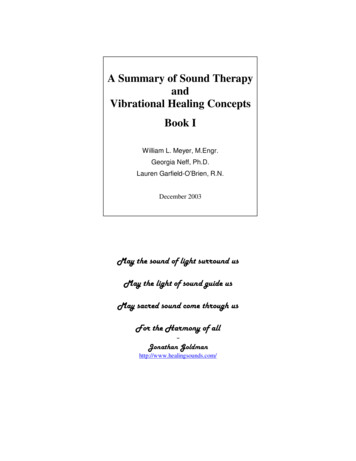
Transcription
A Summary of Sound TherapyandVibrational Healing ConceptsBook IWilliam L. Meyer, M.Engr.Georgia Neff, Ph.D.Lauren Garfield-O’Brien, R.N.December 2003May the sound of light surround usMay the light of sound guide usMay sacred sound come through usFor the Harmony of all--Jonathan Goldmanhttp://www.healingsounds.com/
AcknowledgmentsThe authors of this Summary acknowledge the contributions of Sharry Edwards to sound therapyin general and Human Bioacoustics in particular. Ms. Edwards has researched and publicizedsound therapy for approximately twenty years. The co-authors have each participated in coursesfrom Ms. Edwards in the past, as has Daniel Kunkel who provided “History of Sound Therapy”which influenced several sections of these Concepts.DisclaimerNeither the co-authors nor Ms. Edwards make any representations, warranties orimplications regarding the accuracy or validity of any information contained herein.Sound Therapy is still in the early stages of development, and these concepts areunderstood to the degree that research studies and limited application can provide.These concepts are provided within the framework of ongoing research to promoteprofessional discussion and advancement of sound therapy towards a science.Copyright 2003, William Meyer. This Summary of Concepts may be freely disseminated, inwhole or in part, provided there is no charge for the information and this notice isattached. All copyrights remain the property of the authors. When using a partial versionof this material, please state that it is an abridged version of the Summary and refer thereader to the original, complete version.Index of Book I Summary of ConceptsPart A. Introduction and History of SoundPart B. Frequencies and Sound TherapyPart C. HarmonicsPart D. Musical Scales and RelationshipsIndex of Book II Summary of ConceptsPart E. Theory of a Musical UniversePart F. Concepts of Vocal Analysis
A Summary of Sound Therapy and Vibrational Healing ConceptsCapsule History: over 2,500 years of recorded usage of sound and acoustic principles, since thetime of Pythagoras, are described by numerous authors and researchers. Pythagoras is reported tohave studied in the mystery schools of Egypt which passed down traditions from much earliertimes in Sumeria. Throughout the 19 th and 20 th centuries, notable scientists and researchers suchas Hermann Helmholtz, John Keely, Royal Rife, Albert Abrams, Hulda C lark, Robert Monroe,Robert Sewak and Barbara Hero, to name a few, have contributed their findings and describedthe common ideas and fundamentals of vibrational healing, in the public domain.Paraphrase of a revealing idea: If someone takes the work of another as their own, it is calledplagiarism. If someone takes the work of many others, it is called research. This later idea isexemplified in many scientific endeavors, but it is notably evident in some branches of soundtherapy. This brief summary is intended to point out the origins of the fundamental concepts ofsound therapy or vibrational healing and give credit where credit is deserved.There are no totally new ideas under the sun, only rediscovery of ancient and/or universalprinciples. If we all ow one person to claim or own the work of others who actually made thediscoveries, then we set the stage to have the work withdrawn or destroyed. Hulda Clarkdisplayed great insight and instinct in publishing her work before it could be confiscated by thesame forces that destroyed Royal Rife, Albert Abrams and others.The force of necessity always prompts those “under the gun” to make critical decisions. Onecould choose to ignore the threats and continue their course, or one could go into hiding, or onecould take a defensive position hoping to ward off the threats and attacks. Generally, these waysof dealing with “the gun” have proven both costly and unsuccessful.One could also go on the offensive, declaring the sources known to exist in the public domain todisarm “the gun”. By revealing the actual sources, technology can be discussed, independentevaluations can be made, and hopefully, technology can progress towards a scientific basis. Thisis the approach of the authors and others associated with sound therapy.NOTE: by summarizing the ideas and principles of sound therapy, the authors are by no meanssuggesting that the reader simply take these ideas, hang out a shingle and begin practicing. Infact, considerable knowledge and experience should be acquired before one becomes a soundtherapist or practitioner. Also, care needs to be exercised to maintain discretion in what is offeredto clients (there are no cures) and how services are offered.This summary is not meant to be a complete descript ion of sound therapy. The intended audienceis those who already have some knowledge base and are serious about working in sound therapy.Certain computer programs and databases will be briefly referenced, and these intellectual worksare proprietary to the individual owners. The ideas and principles of proprietary programs, asreferenced from published public domain sources, are matters of general public knowledge.The information that is presented herein comes from many different sources, and much of it isdescribed by multiple authors and researchers. However, there has not been a comprehensivesummary of this public domain information on frequency domain analysis that has been found inSummary of ConceptsA-1
any venue, not does one exist in private works. Further, this summar y describes some researchthat has been performed independently by the authors that has not been previously published.We suggest that this is a work in progress, and we welcome your comments and additions to thiswork. We are convinced that many others a re working in various areas of vocal analysis andsound therapy. We have heard that significant research has been undertaken which has not beenreported. We invite these researchers to contribute in any way they find appropriate.References and Recommended reading:1/ Dr. Scott-Mumby, Keith, 1999; Virtual Medicine: A new dimension in energy healing.2/ Goldman, Jonathan, 1992. Healing Sounds: The Power of ling -sounds.asp3/ Andrews, Ted, 1992; Sacred Sounds: Transformation through Music & Word.4/ Garfield-O’Brien, Lauren K. 1997; Bio-Resonance Therapy.PART A:A.1 Vibration is a primary force in the Universe and the basis of sound therapy: Principle of Vibration – everything is in vibration or constant motion – Keely’s Laws Resonance – every substance on earth and every bone, muscle, organ and microbe inthe body has its own resonant frequency. The composite of the resonant frequencies in the body make up a signature vibration. When the body frequencies are in harmony, the body is healthy; when bodyfrequencies are out of harmony, dis-ease results. Finding and balancing frequencies in the body re -establishes the rhyth m or flow ofenergy in the body so that its natural processes can heal the body. Sounds produced by the voice, instruments or electro-mechanical devices can be usedto balance frequencies in the body.These concepts provide the historical and presentl y accepted basis for sound therapy andvibrational healing. They were adapted from the four references shown above, althoughmany authors describe the same principles.Summary of ConceptsA-2
A.2 History of Sound, Georgia Neff, Ph.D.The arena that is being addressed involves the use of sound as a healing modality. Sound hasbeen used since the most ancient of times in both individual healing and sacred performance.Within the last three decades of the 20 th century the resurgence of various forms of sound healinghas produced remarkable results. Sound, both as pure tones and as music, has been found topositively affect an astonishing array of physiological and psychological parameters. Amongthese are the equalization of brain waves, increasing the depth of breathing, slowi ng heartbeatand pulse, lowering blood pressure, reducing muscle tension, raising body temperature,increasing circulation and endorphin production, boosting immune function, improving memoryand learning, decreasing clerical error, increasing endurance an d productivity, strengtheningdigestion and decreasing depression (Campbell, 1997, p. 64) and, many others ailments andconditions.Music therapist Don Campbell relates the following incident: the famous neurologist OliverSacks, testified before a U.S. senate committee on aging, that he had witnessed the effects ofmusic on Rosalie, a patient with Parkinson's Disease. Rosalie was normally inert, with an EEGthat indicated a comatose state. However, when Chopin's Opus 49 was mentioned to her,Rosalie, a pianist, would begin to change and as she played the music in her head, her motoractivity became normal. If she was able to actually play the piano, she could play fluently forhours. Music therapy programs at universities and clinics around the world h ave become centersof a healing revolution using sound (Campbell, ibid.)Sound therapies presuppose that the "music" of which we are made has become dissonant anddiscordant and that our natural ratios or harmonies have been shifted into disharmonies, i.e .ratios that do not support biochemical and/or structural integrity. Illness is seen as a result of thisdisharmony or lack of integrity. On this premise almost all kinds of sound therapies will agree.The belief that sound can heal and is profoundly i mplicated in health has ancient roots.Pythagoras of Samos (600, BC) considered the father of western science, was deeply imbuedwith the belief that sound, and sound ratios, are the primary forces that hold physical realitytogether. The seven day week, and the seven note musical scale were direct results of his beliefthat the seven visible planets were in ratioed orbits that created specific harmonics. Thoseharmonics were believed to create a "music of the spheres". And his mathematization ofastronomy through music was to lay the foundations of western science and result ultimately inthe work of Kepler and Newton. Most importantly he believed that sound, audible and inaudible,had distinct effects on the health and emotional well being of humans. He prescribed particularmusic to calm and to balance biochemistry. In the early 17th century, Johannes Kepler would usePythagoras' idea of geometrical ratios and the music of the spheres to develop his laws ofplanetary motions and finally accomplish the mathematical task of putting the planets inelliptical orbits around the sun.Though scholars have commonly credited Pythagoras, as the first researcher into theorigin of musical intervals, the decoding of the cuneiform tablets of ancientMesopotamia (southern Iraq) has revealed that the Sumerians simultaneouslydeveloped cuneiform writing and a base-60 number system that allowed them to create"an extensive tonal/arithmetical model for the cosmos." thousands of years beforePythagoras (McCain, 1994) The typical Eurocentric assumption had been that theSummary of ConceptsA-3
rationalistic Greeks refined nascent/primitive mathematical concepts that existedbefore, and made them more useful. But the decoded tablets yield a far different view,one in which the Sumerians created a far reaching allegory in which the physical worldis known by divine mathematical analogy. In this allegory the gods gave divinity notonly to natural forces, but to a "supernatural" intuitive understanding of mathematicalpatterns and psychological patterns (McCain, ibid.).It has long been understood that Pythagoras' alleged experiments in musical intervalswere seriously flawed. What is just coming to be understood is that a much more exactmodel of harmonic theory had predated Pythagoras by millennia. The author of MusicalTheory and Ancient Cosmology (Ernest G. McCain) argues that from these Sumerianroots (and before), theology "is a mathematical allegory with a deeply musical logic."Using Sumerian base-60 numerics, the Babylonians (circa 1800 BC) developed a"formula for the square root of two accurate to five decimal places.or the formula forgenerating all Pythagorean triples.a thousand years before Pythagoras explicated thefirst one." (ibid.).In McCain's exposition of the harmonic and arithmetic talent of the Sumerians andBabylonians, these adepts were themselves dependent on being "grounded in a commonaural (emphasis mine) biological heritage, some of which we share with other animals,and are by no means dependent, as Aristotle noted, on precise numerical definition."(From a correspondence between McCain and musicologist William Thompson).Philosopher of science Karl Popper once remarked that our senses were theories aboutwhat it is important to attend to in the universe. McCain's researches put us in way ofunderstanding that we emerge into our biological forms equipped to process theuniverse in terms of this "mathematical allegory with a deeply musical logic." Whatmay seem a unique gift in some individuals may well be the underlying common logosof matter and being. "The scales on which music is based are not an arbitrary creationof man; they are formed on very definite patterns that are intrinsic to all nature" (ibid).McCain's article deals with the correspondence between music (as a pattern of intervals)and nature, including the psychology of humans. Particularly pertinent is thecorrespondence of the periodic chart (Mendeleev, Newlands, Doeberinger) to themusical octave and musical chords. In fact, the understanding of the overallarrangement of the chart came directly as an illumination of the elements beingnaturally musically arranged. Chemist John Newlands endured years of collegialridicule when he expressed this repeating pattern as a "law of octaves." Mendeleev laterextended this understanding of interval to the chemical properties of the elements andconcluded that these "were the periodic functions of their atomic weights" (ibid,).McCain's article can be found htmlA modern astrophysicist, Trinh Xuan Thuan, has written that " if the cosmos is vast it is by nomeans silent. Nature delights in continuously sending us her notes of music". To understand this"music", in modern terms, is to understand that nature communicates to us in the language ofwave patterns: sound waves, light waves, electromagnetic waves, etc. All these waves are on acontinuum from lower frequencies to higher frequencies. The degree of frequency is how fast, orSummary of ConceptsA-4
often, something vibrates in one second. As chemist Donald Hatch Andrews put it in his book,"The Symphony of Life":“The music of the universe is a cosmic symphony that embraces all the wavesof sound audible and inaudible, all the waves of light visible and invisible, allthe waves of gravity, felt and unfelt, and all the waves of atoms explicit andimplicit. Every scientific conclusion must be consistent with the harmonic(wave aspect) model of the atom (author’s emphasis). Thus it begins to lookmore and more as if our universe is constructed not of matter but of music.”(in Harris, 2000).Everything on the planet, living or not, is radiating frequencie s. We know that this broadcastingof frequency is a primal form of communication. Before the specialization of eyes or ears,before olfactory organs, organisms locate and identify with frequency. We live in a sea offrequencies and we are composed, in essence, of frequencies. The structure of matter is adynamic relationship of frequencies, which is to say, of relative motion. Astronomers speculateon the structure of a distant star based on the various band -widths of frequencies it is emittingand the relationship of those various frequency bandwidths. We are an arrangement offrequency constellations. Nuclear physics has been telling us this story for quite a while. Tounderstand how one substance, or a group of substances, affects other substances is to understandthe primacy of frequency constellations.Also see l for additional history.Some additional thoughts by Bill Meyer:Sound therapy / vibrational healing as referenced in this summary can be described as a mix of harmonicstheory, musical therapy and biofeedback. Sound therapy is dir ectly related to harmonics and music by theuse of combinations of sounds (frequencies), but it definitely is not music by any current standard.Vibrational healing and soundsSome day, in the Future,People will beCured by Sounds.It will be very practical.do not diagnose medical conditions,nor do they cure or heal diseasesof the body. Sound therapy can bedescribed as a noninvasive, energybased alternative health approachto wellness. Master Phillipe of Lyon, 1898Many types of vibrational healing in addition to sound therapy are being practiced around theworld, including audiology (t he Tomatis method), chanting, music, and vocal toning with manymodalities in between. Even modalities that do not directly use sounds should also be included inthe general category of vibrational healing, such as polarity therapy.Summary of ConceptsA-5
A.3 History of Sound, Robert Sewak, 1984.This history is included in the BIO -RESONANCE THERAPY manual,Lauren Garfield-O’Brien, R.N., originally published 1997. 4/The use of music for healing may have originated more than 30,000 years ago. At that timeillness was a grea t mystery, thought to be caused by an evil spirit that had to be expelled from thebody and mind of the afflicted. Each member of the group or family, who was able to performtasks within the group were extremely valuable. The onset of illness created a ha rdship for theother members, perhaps even to the point of jeopardizing the survival of the group itself. It wasimperative, therefore, that the afflicted individual be returned to health as quickly as possible.The earliest form of music healing was a wo rdless wailing, vocal chant that was mono -tonal andrhythmic, the rhythm being based on length of breath and heart pulse. Later, gourd rattles anddrums were added for the spiritual powers attributed to them. The process must have beensuccessful, for eventually, healing specialists began to emerge and became highly valued fortheir knowledge and skill. These individuals were called upon to lead healings and other rituals.Before long, all-important occurrences in tribal life were solemnized with sacred rit es in whichmusic and dancing played a central role, under the direction of the specialist.The development of the long tradition of Shamanism evolved and is still practiced today in someparts of the world. The prevailing musical characteristics of shama nistic healing songs are theirregularity of accent and unexpected interruptions of a steady rhythm. The singing is mostlymono-tonal and is sung without emotion. The rhythm attracts the attention of the patient and maybe hypnotic in effect, for one of the purposes of the healing song is to quiet the patientemotionally.The use of sound in healing is an ancient practice, which has been utilized since before thebeginning of recorded history, with remarkable results. Sound healing was regarded as aneffective and acceptable healing modality until the advent of modern medicine 150 years ago.When we entered the Industrial Revolution, our society underwent a major change, and themedical community underwent a major shift. With the discovery of the chemicals and technology that made surgery possible, voice, sound and music healing was progressively forced intothe background and urged into disregard.The process of healing with sound works because of its ability to calm the mind, by suspendingmuch of the normal day to day conscious activity. During a relaxed state, one is able to accessthe deep realms of consciousness, which allows the subconscious part of the mind to activate andre-energize (harmonize) disruptive conditions. Conversely disruptive, dishar monious sound candisorganize thought processes and create a tense, disharmonic state in the body.It should be noted that the understanding of vibrational healing (and all) concepts tends toimprove with time. We speculate that some of the conclusions formed from the conceptsdescribed herein might be in excess of what the stated researchers actually knew or intended.We have today a broad scope of information, which when taken together, forms a morecomplete picture of the relationships and interactions of harmonics, music and biofrequencies than was likely known 50, 100 or more years ago. WLMSummary of ConceptsA-6
A.4 Bioinformatics, Sound Informatics and Computer SkillsBioinformatics as applied to sound therapy is a scientific discipline that uses vocal recordings asa basis to understand the energy patterns related to human biology. In a more strict sense,bioinformatics is a subset of the larger field of computational biology, which applies quantitativeanalytical techniques in modeling biological systems. Sound informatics may be a better phraseto indicate the more limited scope of bioinformatics that is commonly applied in sound therapy.As a suggestion, the reader is encouraged to perform a Yahoo search on “Bioinformatics”. Thenumber of references to web pages is huge, but it illustrates the amount of interest in this subject,which you may not have on the tip of your tongue.One of our goals in this and following documents is to summarize a range of concepts andtechniques we believe are needed to understand and apply the basic computational tools that areavailable today. We will introduce the idea of databases for bio -frequencies and other types ofdata, computational approaches to acoustical problems, data mining, data visualization, and tipsfor working with data analysis to meet individual sound therapy needs.The main goal of sound informatics is not developing the most elegant or sophisticated analyses;the goal is finding out how living things work as represented by frequencies in the human voice.All of this technology presents a logical foundation to selectively determine the “points” thatreflect underlying energetic health issues and to look for patterns in dynamic sets of data.The application of sound informatics contains potential pitfalls for t hose who look for patternsand make predictions without a complete understanding of where acoustics data comes from andwhat it means. By providing analytical tools, databases, user interfaces, and techniques, soundinformatics makes it possible to do e xciting things such as determining bio-energetic issues andbalancing frequencies that are potentially significant to a client. " Potentially significant" isperhaps the most important phrase, because these tools also provide an opportunity to over interpret data and assign meaning wher e it may not exist.Computer science and sound informatics are only tools to analyze voca l frequencies. These toolsneed to be fully understood to prevent the potentially significant from becoming the potentiallyharmful. Experience and the availability of technical forums for continued discussion andlearning are vital to the success of sound therapists. No single person can be expected to be the“all-knowing guru” for the wide range of knowledge needed in sound therapy and research;many good minds are needed to share their findings and to work together for the benefit of all.Basic computer skills that are required for sound informatics include being able to work with the Windows or another operating system,work with standard word processing and spreadsheet applications (e.g., Word, Excel),manipulate files and different computer media, andwork with audio interfaces.These basic computer skills can not be properly learned at the same time as a sound therapysystem. Reasonable computer skills need to be learned before sound therapy.Summary of ConceptsA-7
A.5 Misinformation and Public DomainThere have been claims of trade secret for various principles and information contained herein.It is the authors’contention that:(1) the status of public domain inform ation precludes any claim as a trade secret for all suchpublished information;(2) once material is publicly disclosed (published), it loses any status it ever had as trade secret;(3) one person cannot claim information discovered by others as p rivate Intellectual Propertyby coining different terms for the ideas or placing a copyright notice on the work of others.Also please remember that copyrights on published work DO NOT confer ownership of the ideasthat are contained in the work to the author – only valid patents confer such rights. Copyrights onpublished works are deemed appropriate to protect the investment by authors to create the work.All information presented herein was acquired directly from the public domainand published sources or from the authors’own research.This information WAS NOT obtained by any illegal or improper means, nor was ittaken from disclosures in any legal discovery process.Further, the concepts and information in this Summary ARE NOT covered by anyexisting or pending patent.Sources of the information are noted, but most concepts have been described bymultiple authors.Further, it is a contention herein that the use of confidentiality agreements can not be ap plied topublic domain information in an attempt to restrict the discussion of public issues. Various issueshave been adjudicated over a number of years, and these issues “have been resolved to thesatisfaction of the parties involved”, as documented elsewhere.NOTE: The above contentions in themselves are neither legal advice nor aninvitation to “out” anyone’s real trade secrets, but are stated here only for therecord. Please consult a legal professional if your have any doubt about yourright to reveal or use information.This document contains copyrighted material the use of which has not always been specificallyauthorized by the copyright owner. We believe the statements and ideas contained hereinconstitute a 'fair use' of any such copyrighted material as provided for in section 107 of the USCopyright Law. For more information go to ary of ConceptsA-8
These Concepts papers are also being published on the Yahoo Group TRUTHsound, whichexists as a forum where those who are interested in any aspect of vibrational healing / soundtherapy can share technical ideas, information, and comment on the work of others. If you'reinterested, you can subscribe by sending an email to:TRUTHsound-subscribe@yahoogroups.comOne of the purposes of TRUTHsound is to promote discussion of the public domain concepts ofsound therapy. We want others to know that w e are truly talking about public issues, and that thediscussion of these issues should benefit individual understanding as well as sound therapy. It ishoped that others will contribute some of their thoughts and ideas to extend these Concepts.When William Me yer began his training in sound therapy in May of 2001, no reference manualexisted for the course. Initially, a notebook was pieced together with bits of key information forprivate use. It was not known at that time that the vast majority of the information was publicl yavailable, even though it was asserted to be both confidential and proprietary. Some of thisinformation forms the basis for these Concepts papers.This public domain information has been the subject of considerable legal maneuvering throughthe seven-year period ending with the July 21 st, 2003 settlement of a lawsuit in Athens County,Ohio. The court docket for this long and complex case may be viewed at the following website:http://www.athenscountycpcourt.org/ - click on the gold “Press Here” button then click on t he“Docket Sheet” link and enter 97CI000264 in the box. Towards the bottom of this lengthy courtrecord, look for the 07/21/03 entry “JOURNAL ENTRY OF SETTLEMENT . .”A considerable amount of the technical documents that were obtained from the public doma inand filed with the court in May 2002 have been sealed. The plaintiff’s lawyer used an obscurepart of the Ohio law which allowed the plaintiff to “allege” that this public domain informationcontained trade secrets, without having to substantiate any allegation . The local Judge who heardthe case sealed the copies of documents containing widely available concepts without allowingarguments concerning what was in the public domain.Allegations about the “confidential/trade secret” status of widely available public domainconcepts are still being made by the plaintiff in the above court case. As one lawyer has recentlystated “There should be no dispute with the general rule of law that once material is publiclydisclosed, it loses its status as trade secret”, and it was also stated that “to assert that [plaintiff]has trade secret protections for information that has been previously disclosed publicly isfrivolous.”These Concepts papers carefully and repeatedly document the sources for the information thathas been used in these publications. This documentation of source data clearly demonstrates thatthe information utilized came from sources that are readily available in the public domain.It should be noted that certain textbooks have been filed in the U.S. Copyright Office. It must bestated that a copyright registration does not create confidentiality or trade secret entitle ments tothe information contained in the copyrighted publication.Summary of ConceptsA-9
The transcribed text of the Athens County court case 97CI000264 is available on the Internet, atthe following website: rds.cfm - clickon the link “The Final Settlement” about half way down in the initial page.NOTE: The above contentions in themselves are not legal advice, and theauthors are not lawyers. These statements are made here only for the record.Please consult a legal professional if your have any doubt about your right toreveal or use information.Summary of ConceptsA-10
Part B: Frequen
A Summary of Sound Therapy and Vibrational Healing Concepts Capsule History: over 2,500 years of recorded usage of sound and acoustic principles, since the time of Pythagoras, are described by numerous authors and researchers. Pythagoras is reported to have studied in the mystery schools of Egypt which passed down traditions from much earlier
